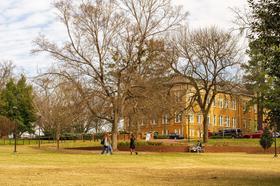Serving 655 students in grades 6-8, Dirksen Junior High School ranks in the bottom 50% of all schools in Illinois for overall test scores (math proficiency is bottom 50%, and reading proficiency is bottom 50%).
The percentage of students achieving proficiency in math is 6% (which is lower than the Illinois state average of 27%). The percentage of students achieving proficiency in reading/language arts is 7% (which is lower than the Illinois state average of 30%).
The student-teacher ratio of 14:1 is higher than the Illinois state level of 13:1.
Minority enrollment is 91% of the student body (majority Hispanic), which is higher than the Illinois state average of 55% (majority Hispanic).
Quick Facts (2025-26)
- Grades: 6-8
- Enrollment: 655 students
- Student-Teacher Ratio: 14:1
- Minority Enrollment: 91%
- Overall Testing Rank: Bottom 50% in IL
- Math Proficiency: 6% (Btm 50%)
- Reading Proficiency: 7% (Btm 50%)
- Science Proficiency: 18% (Btm 50%)
- Source: National Center for Education Statistics (NCES), IL Dept. of Education
Top Rankings
Dirksen Junior High School ranks among the top 20% of public schools in Illinois for:
Category
Attribute
Percent Eligible For Free Lunch
School Overview
Dirksen Junior High School's student population of 655 students has declined by 9% over five school years.
The teacher population of 46 teachers has stayed relatively flat over five school years.
Grades Offered
Grades 6-8
Total Students
655 students
Gender %
Total Classroom Teachers
46 teachers
School Calendar
School Motto
'I am a Peace Builder.'
School Rankings
Dirksen Junior High School ranks within the bottom 50% of all 3,542 schools in Illinois (based off of combined math and reading proficiency testing data).
The diversity score of Dirksen Junior High School is 0.55, which is less than the diversity score at state average of 0.69. The school's diversity has stayed relatively flat over five school years.
Overall Testing Rank
#3301 out of 3542 schools
(Bottom 50%)
(Bottom 50%)
Math Test Scores (% Proficient)
6%
27%
Reading/Language Arts Test Scores (% Proficient)
7%
30%
Science Test Scores (% Proficient)
18%
50%
Student-Teacher Ratio
14:1
13:1
American Indian
n/a
n/a
Asian
n/a
6%
Hispanic
63%
28%
Black
23%
17%
White
9%
45%
Hawaiian
n/a
n/a
Two or more races
5%
4%
All Ethnic Groups
Eligible for Free Lunch
100%
43%
Eligible for Reduced Lunch (12-13)
5%
5%
School Statewide Testing
School District Name
Source: National Center for Education Statistics (NCES), IL Dept. of Education
Profile last updated: 02/09/2025
Frequently Asked Questions
What is Dirksen Junior High School's ranking?
Dirksen Junior High School is ranked #3301 out of 3,542 schools, which ranks it among the bottom 50% of public schools in Illinois.
What percent of students have achieved state testing proficiency in math and reading?
6% of students have achieved math proficiency (compared to the 27% IL state average), while 7% of students have achieved reading proficiency (compared to the 30% IL state average).
How many students attend Dirksen Junior High School?
655 students attend Dirksen Junior High School.
What is the racial composition of the student body?
63% of Dirksen Junior High School students are Hispanic, 23% of students are Black, 9% of students are White, and 5% of students are Two or more races.
What is the student-teacher ratio of Dirksen Junior High School?
Dirksen Junior High School has a student ration of 14:1, which is higher than the Illinois state average of 13:1.
What grades does Dirksen Junior High School offer ?
Dirksen Junior High School offers enrollment in grades 6-8
What school district is Dirksen Junior High School part of?
Dirksen Junior High School is part of Joliet Public School District 86.
School Reviews
Review Dirksen Junior High School. Reviews should be a few sentences in length. Please include any comments on:
- Quality of academic programs, teachers, and facilities
- Availability of music, art, sports and other extracurricular activities
Recent Articles

School Vouchers 2025: Updated Pros and Cons
A 2025 update on school vouchers, including benefits, drawbacks, enrollment trends, and how vouchers affect public and private education.

The Role of Arts in Public Schools (2025 Update)
Explore why arts education remains vital in U.S. public schools, with updated data, new policy context, and insights for parents, students, and educators.

The Role of Sports in Public Schools in 2025
How sports in public schools shape learning, health, and community in 2025, with updated data, trends, and expert insights.





